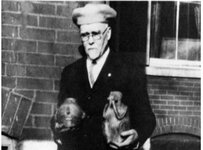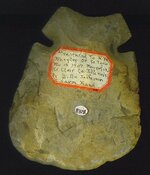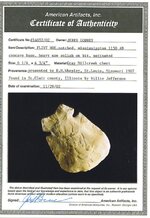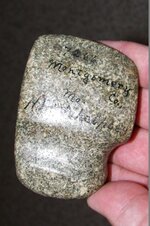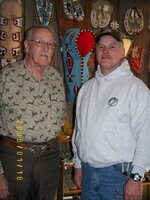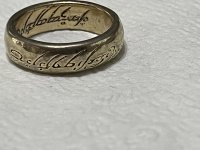The turn of the century offered many opportunities for collectors of Indian artifacts. First, much of the Midwest was still being plowed. Artifacts turned up by the thousands each year. Second, municipalities were expanding, with many mounds being removed. Their contents were regarded as secondary to expansion, and collectors/antiquarians could easily obtain whatever artifacts were uncovered. Thirdly, the number of collectors was small by today's standards, and those with money could easily build a fabulous collection just by having artifacts brought to them.
The period after the Civil War brought the "Curio Shop" to many Main Streets, and there was a public awareness of ancient objects. News had traveled the world about the archaeological finds in the Near East such as Troy, and there was a general interest in collecting. The public had an interest in things that they knew the modern Indians did not produce. If it came from a mound, it was known to be ancient. Pot hunters roamed the countryside in search of landowners who might allow them to dig in their mounds. Luckily, not all landowners were open to such "looting" and there are sites that remain today still undisturbed. But the majority of mounds were plowed down, looted or destroyed in public expansion. St. Louis, once known as Mound City, obliterated its mounds to such an extent, that just a few 174 years after the founding of the city they were no more and mostly forgotten.
It was into this atmosphere that a young Henry Milton Whelpley developed an interest in Indian artifacts. He was born in Battle Creek, Michigan on May 24, 1861, just a month after the firing on Ft Sumter which is considered the start of the Civil War. His father soon joined the Union Army. At the end of the war, the Whelpley family moved to Cobden, Illinois. His father was a collector of Indian artifacts, and this undoubtedly sparked a passion in young Henry that would prove to last a lifetime. Henry was a brilliant student, and graduated from the St. Louis College of Pharmacy in 1883 at just age 22. Nine years later he became a medical doctor and at the same time married Laura Spannagel. Soon he became the Dean of the St. Louis College of Pharmacy, and served as a professor of pharmacognosy, material medical and physiology. He became the Director of Missouri Medical College, and eventually served as President, Secretary and Treasurer of the American Pharmaceutical Association. His professional reputation was nationwide, he was highly respected by his peers and gave many lectures.
Even though he was extremely busy, he found time to pursue his childhood passion for Indian artifacts. He became well known in the archaeological community, and this reputation resulted in him being offered many exceptional artifacts. His keen eye and success in the medical field allowed him to be able to acquire a truly amazing collection. At his death, it was thought to number 50,000 artifacts, but the final cataloging of the collection 40 years later revealed it to be only a third of that figure, or 17,000 artifacts; still a huge collection by today's standards.
Dr. Whelpley was not just a collector, but had a scholarly interest as well, and became heavily involved in the many archaeological organizations of his day, including the Missouri Historical Society, Anthropological Society of St. Louis, Missouri Archaeological Survey and the Academy of Science of St. Louis. The area around St. Louis was exceptionally rich in artifacts, and he not only purchased anything of interest, but also hunted sites himself. His greatest find occurred in July of 1899, when he discovered a massive 20 inch blade in Union County, Illinois. He published it "full size" as a fold out in Prehistoric Implements, written by Warren K. Moorehead, which came out the next year. He wrote in his caption that "This large pre-Columbian piece of Indian flint work must be seen to be fully appreciated."
The collection also includes a large human effigy water bottle, showing a mother nursing a child. It measures 6 inches in height, and the portrait and features are strikingly realistic. Dr. Whelpley wrote in his own hand regarding the vessel. "Found in a small mound in 1876, East St. Louis, Illinois, St. Clair Co., Francis
Another notable artifact he acquired is a large pipe made from red-flint-clay that depicts a discoidal thrower. It was found in a mound in Muskogee, Oklahoma, and stands 8 ½ inches tall. The artwork was tremendous, and it is widely known today as one of the masterpieces of prehistoric art. It shows a game player sitting naked, discoidal in one hand, throwing sticks in the other, ready to participate in the game of "chunky." He does wear a shell bead necklace, sports large earspools, and his hair his worn in a bun. The collection also included five headpots, two Hopewell figurines, hundreds of additional pottery vessels, two nearly 30 inch long blades of obsidian from California, hundreds of spades, celts, axes, plummets and flint arrowheads.
Like many large personal collections at the turn-ofthe-century, there was no way to house the thousands of artifacts, and many were just placed in cartons, crates, cigar boxes and containers. Only a select few could be housed in the curio cabinets of the day.
Dr. Whelpley died a few days after his 65th Birthday in 1926, and his wife Laura was left to disperse the collection. Over the next 17 years, she gave away just a few artifacts to personal friends, which explains why you sometimes see an artifact attributed to his collection. She eventually decided to donate the remaining collection to the Academy of Science of St. Louis in 1943. There the collection sat stored until 1959, when the museum moved it to its new facility at Oak Knoll Park in Clayton, Missouri. Upon arriving, the services of Leonard Blake and Harold W. Mohrman were enlisted to help catalog the collection. This endeavor took more than a year and a half.
In common with the collecting habits of the time, there was sketchy information on most of the artifacts. Eighty percent had what we find common today on most artifacts, just the County and State of origin. Five percent had much more detailed information, and around fifteen percent had no providence at all. There were also some artifacts deemed to be forgeries (fakes).
The collection is still housed at the Museum, although most of it is in storage. Parts of it are routinely changed out for the permanent exhibits, and objects from it have been loaned out to other museums, universities and for traveling exhibitions, such as the recent Hero, Hawk and Open Hand.
The best introduction to the collection is a small publication that is a transaction of the Academy of Science of St. Louis Volume 32 Number 1. This gives an overview of Dr. Whelpley and many of the notable artifacts
in his collection.
Collections the size of and the quality that Dr. H.M. Whelpley gathered are nearly impossible to put together today. The turn-of-the-century was a wondrous time to collect, and we are lucky that the Whelpley collection is mostly intact and still shared with the public. Most of the other great collections ended up being scattered around the country, with only their collecting tags being a reminder of their former caretakers overview of Dr. Whelpley and many of the notable artifacts in his collection.
Source:
This was from a Central States Archaeological Societies http://csasi.org/index.htm Journal issue October 2012 written by Steven R. Cooper EIC
In 2006 while visiting my friend Ben Thompson of St. Louis Missouri, I obtained two exceptional Dr. Henry Milton Whelpley relics.
The period after the Civil War brought the "Curio Shop" to many Main Streets, and there was a public awareness of ancient objects. News had traveled the world about the archaeological finds in the Near East such as Troy, and there was a general interest in collecting. The public had an interest in things that they knew the modern Indians did not produce. If it came from a mound, it was known to be ancient. Pot hunters roamed the countryside in search of landowners who might allow them to dig in their mounds. Luckily, not all landowners were open to such "looting" and there are sites that remain today still undisturbed. But the majority of mounds were plowed down, looted or destroyed in public expansion. St. Louis, once known as Mound City, obliterated its mounds to such an extent, that just a few 174 years after the founding of the city they were no more and mostly forgotten.
It was into this atmosphere that a young Henry Milton Whelpley developed an interest in Indian artifacts. He was born in Battle Creek, Michigan on May 24, 1861, just a month after the firing on Ft Sumter which is considered the start of the Civil War. His father soon joined the Union Army. At the end of the war, the Whelpley family moved to Cobden, Illinois. His father was a collector of Indian artifacts, and this undoubtedly sparked a passion in young Henry that would prove to last a lifetime. Henry was a brilliant student, and graduated from the St. Louis College of Pharmacy in 1883 at just age 22. Nine years later he became a medical doctor and at the same time married Laura Spannagel. Soon he became the Dean of the St. Louis College of Pharmacy, and served as a professor of pharmacognosy, material medical and physiology. He became the Director of Missouri Medical College, and eventually served as President, Secretary and Treasurer of the American Pharmaceutical Association. His professional reputation was nationwide, he was highly respected by his peers and gave many lectures.
Even though he was extremely busy, he found time to pursue his childhood passion for Indian artifacts. He became well known in the archaeological community, and this reputation resulted in him being offered many exceptional artifacts. His keen eye and success in the medical field allowed him to be able to acquire a truly amazing collection. At his death, it was thought to number 50,000 artifacts, but the final cataloging of the collection 40 years later revealed it to be only a third of that figure, or 17,000 artifacts; still a huge collection by today's standards.
Dr. Whelpley was not just a collector, but had a scholarly interest as well, and became heavily involved in the many archaeological organizations of his day, including the Missouri Historical Society, Anthropological Society of St. Louis, Missouri Archaeological Survey and the Academy of Science of St. Louis. The area around St. Louis was exceptionally rich in artifacts, and he not only purchased anything of interest, but also hunted sites himself. His greatest find occurred in July of 1899, when he discovered a massive 20 inch blade in Union County, Illinois. He published it "full size" as a fold out in Prehistoric Implements, written by Warren K. Moorehead, which came out the next year. He wrote in his caption that "This large pre-Columbian piece of Indian flint work must be seen to be fully appreciated."
The collection also includes a large human effigy water bottle, showing a mother nursing a child. It measures 6 inches in height, and the portrait and features are strikingly realistic. Dr. Whelpley wrote in his own hand regarding the vessel. "Found in a small mound in 1876, East St. Louis, Illinois, St. Clair Co., Francis
Another notable artifact he acquired is a large pipe made from red-flint-clay that depicts a discoidal thrower. It was found in a mound in Muskogee, Oklahoma, and stands 8 ½ inches tall. The artwork was tremendous, and it is widely known today as one of the masterpieces of prehistoric art. It shows a game player sitting naked, discoidal in one hand, throwing sticks in the other, ready to participate in the game of "chunky." He does wear a shell bead necklace, sports large earspools, and his hair his worn in a bun. The collection also included five headpots, two Hopewell figurines, hundreds of additional pottery vessels, two nearly 30 inch long blades of obsidian from California, hundreds of spades, celts, axes, plummets and flint arrowheads.
Like many large personal collections at the turn-ofthe-century, there was no way to house the thousands of artifacts, and many were just placed in cartons, crates, cigar boxes and containers. Only a select few could be housed in the curio cabinets of the day.
Dr. Whelpley died a few days after his 65th Birthday in 1926, and his wife Laura was left to disperse the collection. Over the next 17 years, she gave away just a few artifacts to personal friends, which explains why you sometimes see an artifact attributed to his collection. She eventually decided to donate the remaining collection to the Academy of Science of St. Louis in 1943. There the collection sat stored until 1959, when the museum moved it to its new facility at Oak Knoll Park in Clayton, Missouri. Upon arriving, the services of Leonard Blake and Harold W. Mohrman were enlisted to help catalog the collection. This endeavor took more than a year and a half.
In common with the collecting habits of the time, there was sketchy information on most of the artifacts. Eighty percent had what we find common today on most artifacts, just the County and State of origin. Five percent had much more detailed information, and around fifteen percent had no providence at all. There were also some artifacts deemed to be forgeries (fakes).
The collection is still housed at the Museum, although most of it is in storage. Parts of it are routinely changed out for the permanent exhibits, and objects from it have been loaned out to other museums, universities and for traveling exhibitions, such as the recent Hero, Hawk and Open Hand.
The best introduction to the collection is a small publication that is a transaction of the Academy of Science of St. Louis Volume 32 Number 1. This gives an overview of Dr. Whelpley and many of the notable artifacts
in his collection.
Collections the size of and the quality that Dr. H.M. Whelpley gathered are nearly impossible to put together today. The turn-of-the-century was a wondrous time to collect, and we are lucky that the Whelpley collection is mostly intact and still shared with the public. Most of the other great collections ended up being scattered around the country, with only their collecting tags being a reminder of their former caretakers overview of Dr. Whelpley and many of the notable artifacts in his collection.
Source:
This was from a Central States Archaeological Societies http://csasi.org/index.htm Journal issue October 2012 written by Steven R. Cooper EIC
In 2006 while visiting my friend Ben Thompson of St. Louis Missouri, I obtained two exceptional Dr. Henry Milton Whelpley relics.
Attachments
Upvote
0



